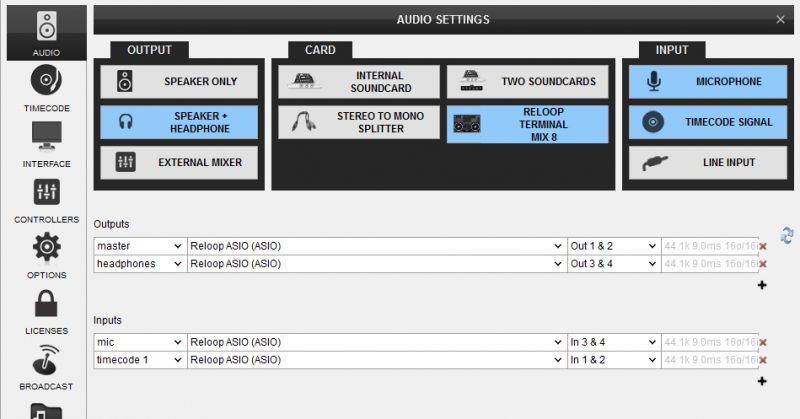RELOOP TERMINAL MIX 8

SETUP
Firmware & Drivers
Firmware: Update the firmware of the unit to the latest version from http://www.reloop.com/reloop-terminal-mix-8
Drivers (for Windows only): Install the latest Reloop ASIO drivers from http://www.reloop.com/reloop-terminal-mix-8
No drivers are required for Mac OSX computers
VirtualDJ Setup
Once VirtualDJ 8 is launched, a Login Window will appear. Login with your virtualdj.com account.
A Pro Infinity or a Subscription License is required to fully use the Reloop Terminal Mix 8. Without any of the above Licenses, the controller will operate for 10 minutes each time you restart VirtualDJ.
http://www.virtualdj.com/buy/index.html

Click on the Use Soundcard button, if your speakers are connected to the Master Output of the unit at the rear panel and your Headphones to the front socket.
Click on the Change Skin button to load the 4 Decks Default Skin of VirtualDJ.
Click to OK.
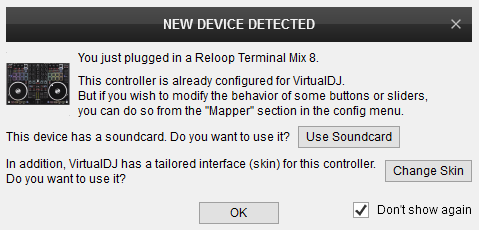
The unit is now ready to operate.
MIDI Operation
Find more details at http://www.virtualdj.com/wiki/VDJ8script.html
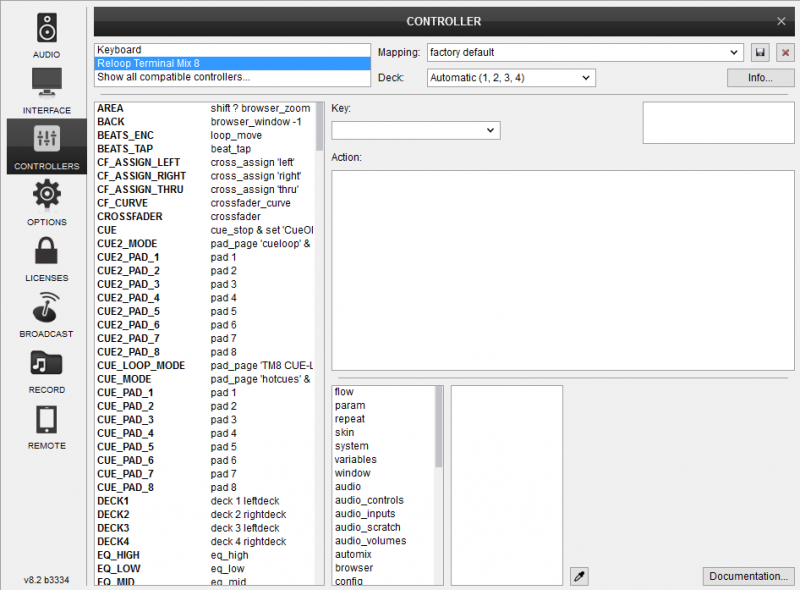
AUDIO Setup
Alternative Audio setups can be applied in the same window. See Advanced Setup
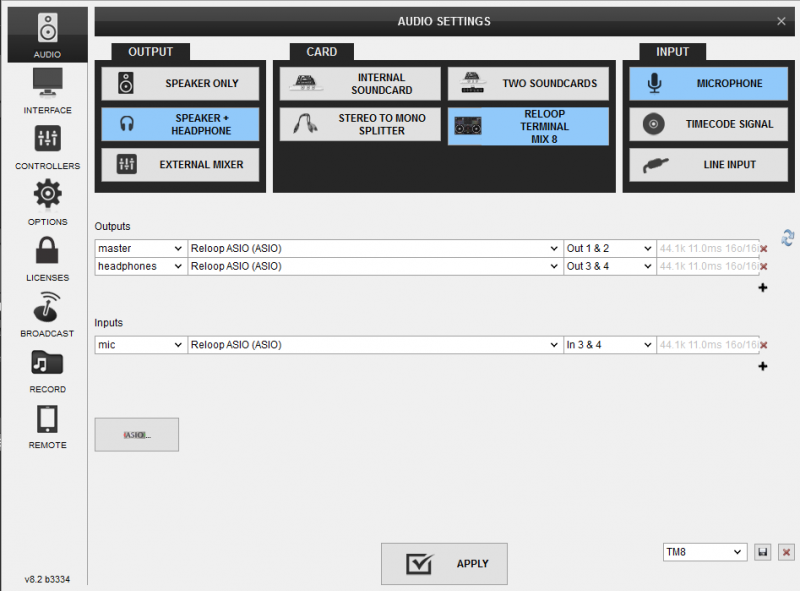
For further software settings please refer to the User Guides of VirtualDJ 8.
http://www.virtualdj.com/manuals/virtualdj8/index.html
LAYOUT
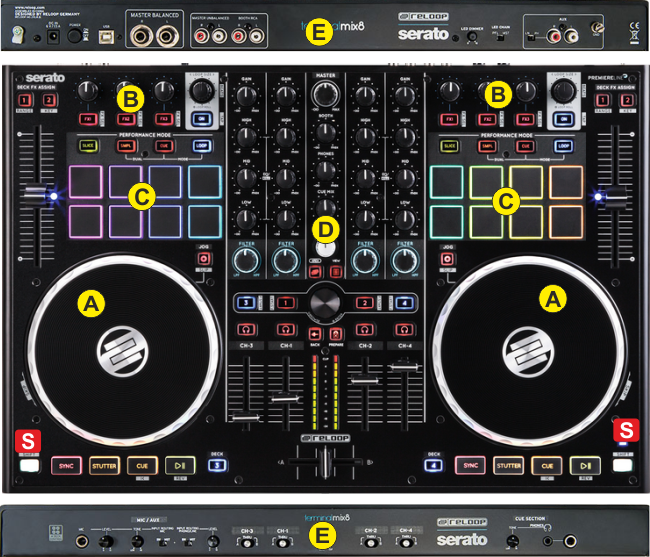
S SHIFT. Press and hold this button to access secondary functions of other controls on the Terminal Mix 8 .
The functionality of each button and knob per section (as shown in the image below) will be explained in detail in the next chapters
A. Deck Controls
B. Effect Controls
C. Pads
D. Mixer & Browser
E. Front & Rear
DECK CONTROLS
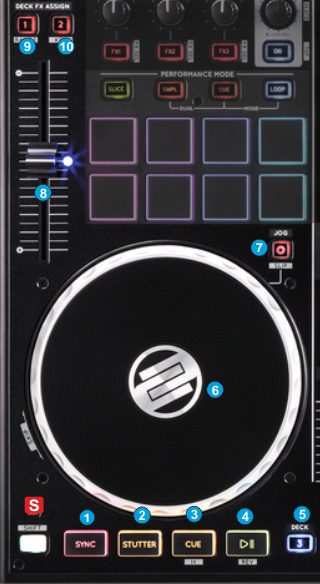
- SYNC. Press this button to automatically match the corresponding Deck's tempo with the opposite Deck's (or the Master Deck’s if using a 4 decks Skin) tempo and phase.
Hold SHIFT down and then press this button to set this deck as Master Deck. When a Deck is set as Master Deck, all other decks will sync to this deck. - STUTTER. Press this button to return to the last paused position and play the track from there (play stutter)
- CUE. When the Deck is paused, you can set a temporary Cue Point by moving the Platter to place the Audio Pointer at the
desired location and then pressing the Cue Button. During playback, you can press the Cue Button to return the track to this Cue Point. (If you did not set a Cue Point, then it will return to the beginning of the track.). If the Deck is paused, you can press and hold the Cue Button to play the track from the Temporary Cue Point. Releasing the Cue Button will return the track to the temporary Cue Point and pause it. To continue playback without returning to the Temporary Cue Point, press and hold the Cue Button, then press and hold the Play Button, and then release both buttons.
Press and hold SHIFT and then press this button to return to the beginning of the track. - PLAY/PAUSE. Plays / Pauses the track. Press and hold SHIFT and then press this button to play the track in reverse.
- DECK SELECT. Switch Control for the Left decks (1 and 3) and Right Decks (2 and 4).
- JOGWHEEL. Touch sensitive platter for scratching (vinyl mode), bending (CD Mode) or Seek mode. In Scratch mode, use the jogwheel to scratch and the outer ring to bend.
Hold SHIFT down and then use the jogwheel to navigate through the track (seek mode) - JOG MODE. Use this button to toggle between the Scratch (Vinyl) and Bend (CD) mode. Hold SHIFT and then press this button to enable the Slip Mode. Several software functions (such as Jogwheel movements, HotCues and Loops) will apply temporary on the track, and the track will return to the position it would have been when those functions are not triggered.
- PITCH. Controls the track's playback tempo. The blue led indicates that the pitch fader of the unit is on zero (center) position
- RANGE (SHIFT). Hold SHIFT down and then press this button to select the next available pitch range. The pitch range applies to all VirtualDJ decks (global setting)
- KEY (SHIFT). Hold SHIFT down and then press this button to enable/disable Master Tempo (Keylock) on the deck.
EFFECTS & LOOPS

This section offers control of 3 Effect slots per deck, loop, loop roll actions and Master video Effects and Video Transition controls.
- FX1 knob. Controls the 1st parameter of the selected effect of FX Slot 1. Hold SHIFT down and use this knob to control the 2nd parameter of the selected effect of FX Slot 1.
- FX2 knob. Controls the 1st parameter of the selected effect of FX Slot 2. Hold SHIFT down and use this knob to control the 2nd parameter of the selected effect of FX Slot 2.
- FX3 knob. Controls the 1st parameter of the selected effect of FX Slot 3. Hold SHIFT down and use this knob to control the 2nd parameter of the selected effect of FX Slot 3.
- FX1 ON. Press this button to enable/disable the selected effect of FX Slot 1. Hold SHIFT down and then press this button, to select the next available effect for FX Slot 1.
- FX2 ON. Press this button to enable/disable the selected effect of FX Slot 2. Hold SHIFT down and then press this button, to select the next available effect for FX Slot 2.
- FX3 ON. Press this button to enable/disable the selected effect of FX Slot 3. Hold SHIFT down and then press this button, to select the next available effect for FX Slot 3.
- LOOP ENC. Turn the encoder anti-clockwise to half the size of the loop and clockwise to double it. When a Loop is triggered. hold SHIFT down and then use the encoder to move the triggered loop forward or backwards by 1 beat.
Push the encoder to toggle between normal and Roll Loop mode. - LOOP ON. Press this button to trigger a loop of the selected size (toggle function). When Roll loop mode is selected, the button will apply a temporary (while pressed) Loop Roll and the track will return to the position it would have been if the Loop was never triggered.
Hold SHIFT down and then use this button (for at least 4 times) to manually tap the tempo of the track - FX ASSIGN 1. Use the left side button to enable/disable the selected Video Transition. Use the right side button to enable/disable the selected Master Video Effect.
- FX ASSIGN 2. Use the left side button to select the next Video Transition. Use the right side button to select the next Master Video Effect.
PADS
3 Dual modes are also offered. Press 2 PAD Mode buttons (from SAMPL, CUE and LOOP) at the same time to access one of the dual modes.
Each time a mode is selected, the relative Page will be displayed in the Pads section of the VirtualDJ GUI
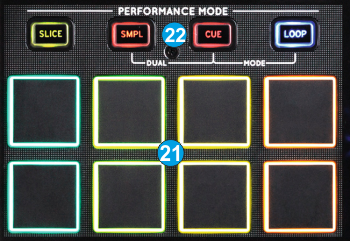
Slicer & Slicer Hold mode
Press the SLICE mode button to set the PADs to SLICER mode. The Slicer page will be automatically displayed on the Pads section of the VirtualDJ GUI
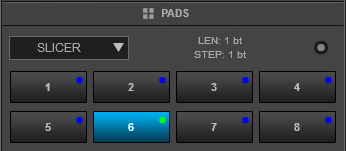
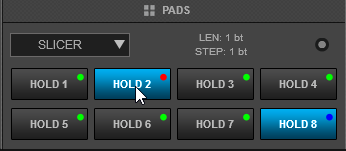
The eight pads represent eight sequential beats—"Slices"—in the Beat Grid. The playing Slice is represented by the currently green lit pad. The green light will "move through the pads" as it progresses through each eight-Slice phrase. Press a pad to repeat that Slice (hold it down if you want to keep looping it).
Once the Pad is released the track will continue to play from the position it would have been if the pad was never pressed.
Hold SHIFT button down and then use the same Pads to use the Slicer in Hold mode. In this mode, the slices are memorized (using the last triggered ones)
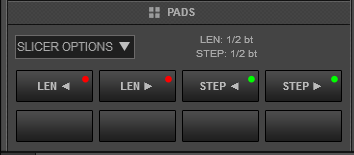
If the SLICER mode is selected, press again the same Mode button to receive the Slicer Options. The special TM8 Slicer Options page will be then automatically selected in the Pads section of the VirtualDJ GUI
Use Pads 1 and 2 to increase/decrease the length of the applied loop on the slice.
Use Pads 3 and 4 to increase/decrease the step of the Slice.
Sampler mode
Press the SMPL mode button to set the PADs to SAMPLER mode.The Sampler page will be then displayed on the Pads section of the VirtualDJ GUI
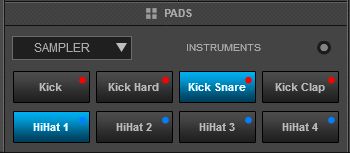
Each one of the pads triggers a sample from the selected Sampler Bank of VirtualDJ. If a bank has less than 9 samples, both sides of the Terminal Mix 8 will control the same samples. If a bank has more than 8 samples, the left side of the Terminal Mix 8 will control samples 1 to 8 and the right side samples 9 to 16. Each one of the Pads will automatically get the assigned color of each sample.
Press the pads to trigger a sample. Depending on the selected trigger mode, hold SHIFT down and then use the same pads to stop the sample.
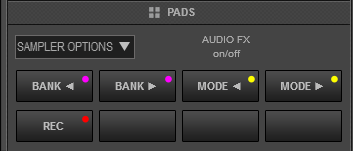
If the SAMPLER mode is selected, press again the same Mode button to receive the Sampler parameters (led will blink).
Use Pads 1 and 2 to select the previous and next available Sampler Bank.
Use Pads 3 and 4 to select the next sampler trigger mode (On/off, Hold, Stutter and Unmute)
Use Pad 5 to record the deck into a new Sample.
HotCues mode
Press the CUE mode button to set the PADs to HOT CUE mode. The Hotcues Page will be then displayed in the Pads section of the VirtualDJ GUI
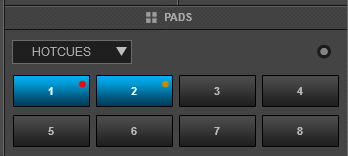
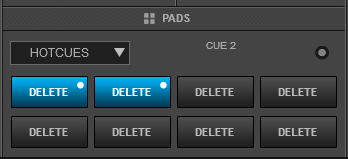
Each one of the 8 pad assigns a Hot Cue Point or returns the track to that Hot Cue Point.
When a Hot Cue Button is unlit, you can assign a Hot Cue Point by pressing it at the desired point in your track. Once it is assigned, the Hot Cue Button will light up.
Hold SHIFT and then press a pad to delete its assigned Hot Cue Point. Red leds will blink if a HotCue point exists
CueLoop mode
If the CUE mode is selected, press again the same Mode button to set the PADs to CUE-LOOP mode. The LED of the CUE mode button will blink as an indication and the Cueloop Page will be then displayed in the Pads section of the VirtualDJ GUI
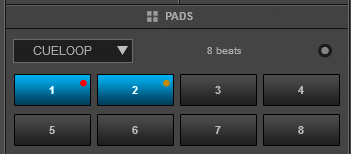
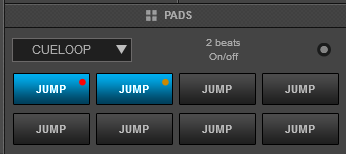
Each one of the 8 pad assigns a Hot Cue Point or returns the track to that Hot Cue Point, but in both cases, it also triggers a Loop at that point. The applied loop can be triggered momentary (while pressed) or toggle (on/off) and the behavior is changed from the menu of this page.
Hold SHIFT and then press a pad to jump to the HotCue point without turning the Loop off
Loop mode
Press the LOOP mode button to set the PADs to Loop mode. The special TM8 Loop page will be then displayed on the Pads section of the VirtualDJ GUI.
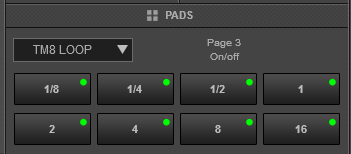
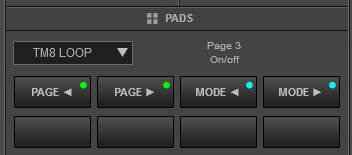
Each one of the PADs triggers a loop of a different size (from 1/32 to 128 beats) depending on the selected Loop page (1-6)..Press the same pads to disable the applied loop or another one to apply a loop of a different size. The LOOP encoder can be also used to half/double the size.
Hold SHIFT down and then use Pads 1 and 2 to select a different page (bank) of loop sizes and Pads 3 and 4 to select a different Loop trigger mode (on/off, Hold or Roll)
Manual Loop mode
If the LOOP mode is selected, press again the same Mode button to set the PADs to Manual LOOP mode (led will blink). The Manual Loop page will be then displayed in the Pads section of the VirtualDJ GUI
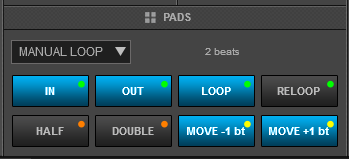
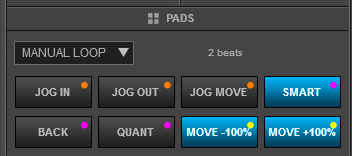
Each one of the 8 pad offers a different loop function.
Use Pads 1 and 2 to set a Loop Entry (In) and a Loop Exit (Out) point for manual looping.
Use Pads 3 to turn off the Loop (if enabled) or trigger a Loop of the selected size in beats
Use Pad 4 to repeat the last triggered loop (reloop)
Use Pads 5 and 6 to half/double the size of the Loop.
Use Pads 7 and 8 to move the Loop (if enabled) forward/backwards by 1 beat
While SHIFT is pressed use ..
Pad 1 to set the Jogwheel to Loop In Adjust mode and use the Jogwheel to fine adjust the Loop In position
Pad 2 to set the Jogwheel to Loop Out Adjust mode and use the Jogwheel to fine adjust the Loop Out position
Pad 3 to set the Jogwheel to Loop Move Adjust mode and use the Jogwheel to fine move the Loop through the track.
Pad 4 to enable/disable Smart Loop. When Smart Loop is enabled (default status), using Loop In and Loop Out buttons to trigger a Manual Loop, will result of a seamless loop (track will stay on beat)
Pad 5 to enable/disable Loop Back mode. When Loop Back mode is enabled, and an Auto Loop is enabled, the current track's position will be considered as the Loop Out (Exit) point of the loop and the passed part of the track will be looped.
Pad 6 to enable/disable Quantize Loop mode. When enabled, the Loop In point of a Loop will be snapped to the nearest beat
Pad 7 and 8 to move the loop (if enabled) forward/backwards by the amount of the size of the loop.
HotCue & Sampler dual mode
Press the CUE and the SAMPL mode buttons at the same time to set the PADs to the Hot Cue & Sampler Dual mode. The special TM8 Cue-Sampler page will be then displayed in the Pads section of the VirtualDJ GUI
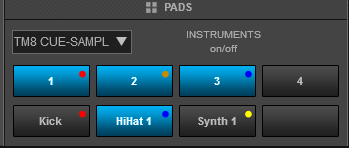
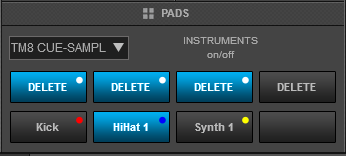
In this mode the top 4 PADs assigns a Hot Cue Point (1 to 4) or returns the track to that Hot Cue Point.
Hold SHIFT and then press a pad to delete its assigned Hot Cue Point.
The 4 lower PADs will trigger a Sample (slots 1 to 4) Depending on the selected trigger mode, use SHIFT and the same pads to stop the sample.
HotCue & Loop dual mode
Press the CUE and the LOOP mode buttons at the same time to set the PADs to the Hot Cue & Loop Dual mode. The special TM8 Cue-Loop page will be then displayed in the Pads section of the VirtualDJ GUI.
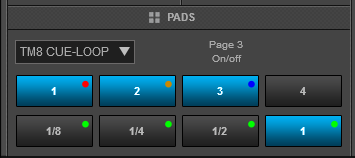
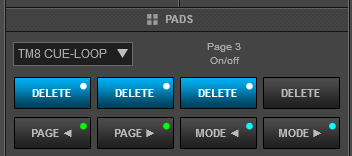
In this mode the top 4 PADs assigns a Hot Cue Point (1 to 4) or returns the track to that Hot Cue Point.
Hold SHIFT and then press a pad to delete its assigned Hot Cue Point. Red leds will blink if a HotCue point exists
The 4 lower PADs will trigger a Loop of a different size, depending on the selected Loop Page (bank).
Hold SHIFT down and then use Pads 5 and 6 to select a different Loop Page (bank) with different sizes and Pads 7 and 8 to select a different Loop trigger mode (On/Off, Hold or Roll)
Loops & Sampler dual mode
Press the SAMPL and the LOOP mode buttons at the same time to set the PADs to the Sampler & Loop Dual mode. The special TM8 Loop-Sampler page will be then displayed on the Pads section of the VirtualDJ GUI.
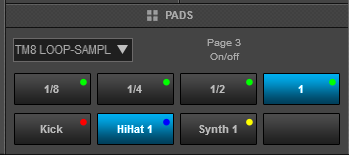
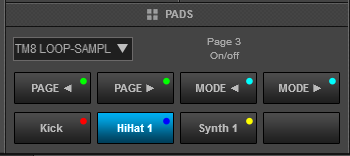
In this mode, the 4 top PADs will trigger a Loop of a different size, depending on the selected Loop Page (bank).
Hold SHIFT down and then use Pads 1 and 2 to select a different Loop Page (bank) with different sizes and Pads 3 and 4 to select a different Loop trigger mode (On/Off, Hold or Roll)
The 4 lower PADs will trigger a Sample (slots 1 to 4) Depending on the selected trigger mode, use SHIFT and the same pads to stop the sample.
MIXER & BROWSER Controls
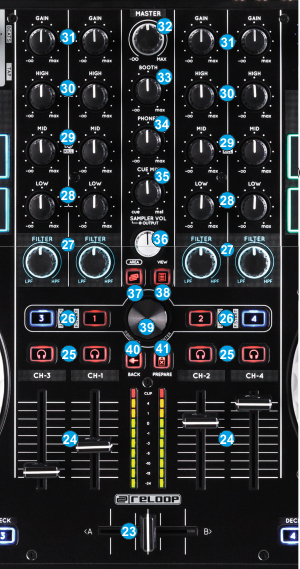
- CROSSFADER. Blends audio between the channels assigned to the left and right side of the crossfader.
- VOLUME. Adjust the Volume of each channel.
- PFL. Press these buttons to send each channel to the Headphones Output channel.
- LOAD. Press these buttons to load the selected track from the Browser to decks 1 to 4. The LED of the button will be on if the deck is loaded. Hold SHIFT down and then press one of these buttons to enable the Fader Start on a deck.
- FILTER. Use this knob to apply a High/Low Pass Filter to the deck. In middle position no filter is applied.
- EQ LOW. Adjust the Low (Bass) frequencies for each mixer channel.
- EQ MID. Adjust the Mid frequencies for each mixer channel.
- EQ HIGH. Adjust the High (Treble) frequencies for each mixer channel.
- GAIN. Adjust the Gain of each mixer channel.
- MASTER VOLUME. Adjust the level of the Master Output. Hardware operation - movement not visible on the VirtualDJ GUI
- BOOTH VOLUME. Adjust the level of the Booth Output. Hardware operation – movement not visible on the VirtualDJ GUI.
- HEAPHONES LEVEL. Adjust the Volume Output of the Headphones Channel. Hardware operation – movement not visible on the VirtualDJ GUI.
- HEADPHONES MIXING. Adjust how the Channels and the Master Output blend at the Headphones Channel.
- SAMPLER VOLUME. Adjust the Master Output Volume of the VirtualDJ Sampler
- AREA. Cycles through the available Center panels of the default VirtualDJ GUI (Mixer, Video, Scratch and Master). Hold SHIFT down and then press this button to get the Browser Zoom view (with mini decks).
- VIEW. Cycles through the views of the Sideview (Automix, Sidelist, Sampler, Karaoke and Clones). Hold SHIFT down and then press this button to show/hide the Sideview.
- BROWSE ENC. Scroll through files of folders. Push the encoder to enter the Songs List (if focus is on the folders list) or load the selected track to the first available deck. Hold SHIFT down and then push the encoder to set focus to the Folders list or open/close the subfolders if focus is on the Folders list already.
- BACK. Set focus to the previous Browser Window (Folders List, Songs List and Sideview).
- PREPARE. Add the selected track to the Automix List. Hold SHIFT down and then press this button to add the selected track to the Sidelist.
FRONT & REAR PANELS

MIC INPUT. Connect your 1/8” Microphone to this Input.
MIC LEVEL/TONE. Adjust the signal Level and the Tone of the Microphone Input. Hardware operations (not visible on the VirtualDJ GUI), however the Microphone Input can be routed into the software (see Advanced Setup)
INPUT ROUTING MIC. Select with this switcher if the Microphone Input will be directly routed to the Master Output of the TM8 (MST position) or to the software mix (SW position).
INPUT ROUTING LINE. Select with this switcher if the Line In Input will be directly routed to the Master Output of the TM8 (MST position) or to the software mix (SW position).
LINE LEVEL. Adjust the signal Level and the Tone of the Phone/Line Input. Hardware operations (not visible on the VirtualDJ GUI), however the Line/Phono Input can be routed into the software (see Advanced Setup)- CF ASSIGNS. Define which mixer channels (decks) will be assigned as left (A position) or right (B position) side of the crossfader. If in a channel is at THRU position, the channel will be heard in Master Output regardless of the Crossfader position.
- CF CURVE. Define how the crossfader will blend the mixer channels.(from Smooth to Cut/Scratch curve)
- HEADPHONES TONE. Adjust the tone of the Headphones Output Channel. Hardware Operation, not visible on the GUI of VirtualDJ.
- HEADPHONES PHONES INPUT. Connect a pair of Headphones to this socket (1/4” or 1/8”). The Volume of this Output is controlled by the knob at the top panel

- POWER: A Power connection (using the provided AC/DC adapter) is required. While the power is switched off, plug the cable into TM8 first, and then plug the cable into a power outlet. Use the Power Switch to turn the TM8 on and off. Turn on the TM8 after all input devices have been connected and before you turn on amplifiers. Turn off amplifiers before you turn off TM8
- USB. This USB connection sends and receives audio and control information from a connected computer.
- MASTER OUTPUT BALANCED (TRS): Connect this low-impedance TRS output to a PA system or powered monitors. The level of this output is controlled with the Master knob on the top panel.
- MASTER OUTPUT UNBALANCED (RCA): Use standard RCA cables to connect this output to a speaker or amplifier system. The level of this output is controlled by the Master knob on the top panel.
- BOOTH OUTPUT (RCA): Use standard RCA cables to connect this output to a booth monitoring system. The level of this output is controlled by the Booth knob on the top panel.
- LED DIMMER. Use this knob to select the desired illumination for the LEDs when are in Off state
- LED CHAIN. Set the switcher to PFL position to get the Pre-fader Output Level of each deck/side on the VU meters. Set the switcher to MST position to get the Master Output Volume on the VU Meter Leds.
- LINE INPUT. Connect your audio sources to this input. Select the appropriate PHONO/LINE position, depending on the analogue media source connected to the Input socket.
ADVANCED SETUP
The Terminal Mix 8 offers 2 stereo Inputs. An AUX at the rear side (Input Channels 1 and 2) and a Microphone Input at the front (Input channels 3 and 4). Each one of the Inputs can be routed through the Master Output directly (rear switcher to MST position) or through VirtualDJ (frear switcher to SW position). A Level knob for each Input is offered to adjust its Input Volume.
Recording & Broadcasting
The unit offers the ability to record the Master Output directly from VirtualDJ record button (in the MASTER center panel) without any further adjustmants. The Microphone and the AUX Inputs can be also recorded and controlled, it those are at the SW position.
In this case a Line In and a Microphone line need to be manually added to the audio configuration.
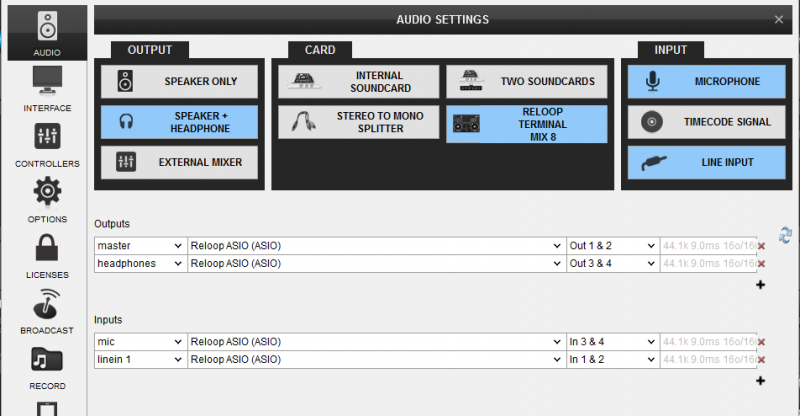
Note. If the Microphone (or the Line Input) is not required to be recorded, it is advised not to route the Microphone through the software, as an additional latency will be applied.
Timecodes
Even though the Terminal Mix 8 is not designed to support Timecoded CDs and Vinyls (DVS), the unit is capable to offer Timecode setups. In theory only a single Timecode device can be used (connection to the AUX Input), however a second Timecoded device can be also connected to the MIC Input (and adjust the Level of its signal).
The following audio configuration is showing a single Timecode input.
